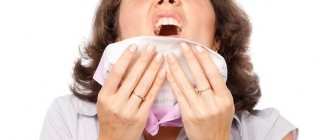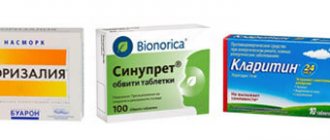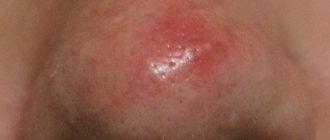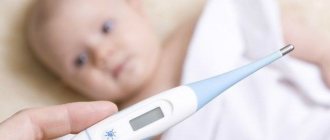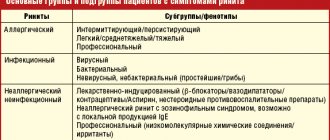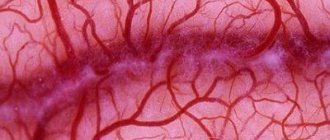Most people believe that a runny nose is not a reason to see a doctor. Vasoconstrictor drops can be bought at any pharmacy without a prescription; they quickly help relieve symptoms and improve nasal breathing.
But this doesn't always happen. Self-selected medications are ineffective in half the cases. Among the most common complaints are the following: patients have a stuffy nose for a long time, drops do not help, and the condition worsens.
In this case, you need to consult a doctor. After all, only an experienced specialist can make an accurate diagnosis and prescribe the right drug after additional examination of the patient.
Reasons for the ineffectiveness of drops
Vasoconstrictor drugs have strict indications for use. They reduce swelling of the nasal mucosa by narrowing the capillaries. If the cause of nasal congestion is not clearly established, the use of drops may not bring the desired result.
Difficulty in nasal breathing can occur in the following situations:
- For allergic rhinitis. Swelling of the mucous membrane occurs due to the release of large amounts of histamine, which increases vascular permeability and causes nasal congestion. In this case, vasoconstrictor drops will be ineffective. The main role in treatment is played by antihistamines and intranasal glucocorticosteroids. The allergic nature of the disease is indicated by a prolonged runny nose with liquid snot that does not change color or consistency, redness of the eyes, tearing, and sneezing.
- With a deviated nasal septum. This feature can be either congenital or acquired as a result of injuries or blows.
- Polyps are a common cause of difficulty breathing. Growths of the mucous membrane block the lumen of the nasal passage, completely blocking it. The main method of treatment is surgical. Vasoconstrictor drops in this case are useless and contraindicated.
- Adenoids, or inflammation of the pharyngeal tonsil, is more common in children. Lymphatic tissue increases in size and swells, partially blocking the lumen of the choana (internal opening of the nose).
- Sinusitis most often has a bacterial nature and is accompanied by inflammation of the paranasal sinuses. Patients usually have a very stuffy nose, an increase in temperature, and pain in the projection of the maxillary sinuses, which intensifies when the head is tilted. Antibiotics play the main role in treatment. Vasoconstrictors are only an auxiliary means and are not used independently in this situation.
Before starting to use any nasal drops, it is necessary to accurately establish the diagnosis and exclude surgical pathology. Otherwise, vasoconstrictor drugs may cause harm.
There are only two most common reasons for the ineffectiveness of nasal drops:
- Incorrect diagnosis. A person without medical education will not always be able to distinguish nasal congestion of an infectious nature from an allergic one, or to determine the signs of the development of sinusitis. Only a doctor can prescribe effective treatment.
- Use of drops for too long (more than 10 days). One of the unpleasant features of this group of drugs is addiction. According to the instructions, it is not recommended to use the product for more than 7 days. If you exceed the time limit, the patient will begin to complain that the nose cannot breathe, the drops do not help, despite increasing the frequency of administration.
Stuffy nose, drops don’t help: what to do?
A stuffy nose is a common problem during colds and allergy season. A clogged nose only seems like a small problem, but in fact, this nuisance can significantly worsen the quality of life:
- A person cannot breathe deeply
- Does not distinguish between a variety of aromas
- Enjoy food
- Breathing through your mouth, which leads to dry larynx and lips
- Experience headaches and general malaise due to poor breathing.
- Have trouble sleeping at night
The easiest way to get rid of it is to put drops in your nose. But few people know that in order for drops to really help your problem, you need to choose them correctly. It often happens that a runny nose does not go away for a very long time, despite the fact that you use the drops regularly. The wrong choice of drug is to blame for this.
It is important to understand what caused the runny nose: a virus, a cold or an allergy. That is why it is always recommended to go to a specialist for this consultation, and not to a pharmacy.
A person may develop a runny nose for the following reasons:
- the human body's reaction to any allergen
- hypothermia, cold
- viral disease
- adenoid growth
- neoplasm in the sinuses, nasal passages, nasal septum.
- deformation of the nasal septum
Any process can provoke inflammation of the mucous membrane. As a result, swelling of the mucous membrane appears and the nasal passages decrease in diameter. Swollen nasal sinuses do not allow mucus to pass through and therefore become blocked. If you have been using drops for a long time, but do not see any improvement in your condition and your nose is stuffy most of the time, you should use alternative treatment methods.
The following ways will help you get rid of a runny nose:
- Nasal rinsing. This rinsing is done using a saline solution (for 1 liter of purified water, only 5 g of sea salt). This procedure is performed several times a day, always before bedtime and after sleep. Flushing will help clear mucus blockages and flush out excess mucus, opening up the airways. Washing is done with a special “cuckoo” device.
- Compliance with drinking regime. This feature will allow you not only to improve your condition, but also to thin out the mucus in your nose. That is why it goes away easily and quickly, and you recover. You should drink at least 2 liters of water per day (if an adult is sick). If the nature of your runny nose is a cold, you should not drink water, but hot drinks (teas, herbal infusions, hot lemonade, raspberries, broths with mustard and horseradish).
- Warming up. If the runny nose is of a cold nature, you can get rid of it by warming the body and sinuses. Mustard plasters, hot baths and showers, steaming feet (preferably with mustard powder) are useful. Warming up should be done before bedtime.
- Inhalation. Necessary in order to expand the sinuses and make mucus more liquid. Warming up and inhalation are accomplished by inhaling vapors from hot water, or potatoes, for example. It’s good to add a couple of drops of essential oil to the water.
How to get rid of a stuffy nose?
Diagnostic features
Before starting treatment, it is necessary to establish an accurate diagnosis. If you have problems with nasal congestion, you should contact an otolaryngologist. Using additional research methods, the doctor will be able to accurately indicate the cause of difficulty breathing and prescribe the correct correction.
The following diagnostic stages are distinguished:
- Collection of complaints and anamnesis features. If the occurrence of symptoms is associated with the flowering of trees and grasses, this indicates an allergic nature. If you have contact with sick children or adults, you should pay attention to viral rhinitis.
- Rhinoscopy allows you to examine the mucous membrane of the nasal cavity, determine its color, the presence of hemorrhages, foreign objects, polyps or deviated septum.
- If indicated, the doctor may prescribe an x-ray of the sinuses.
- General blood analysis. An increase in white blood cell count and erythrocyte sedimentation rate indicates a bacterial infection. A high level of lymphocytes can be observed with viral infection of the mucous membrane. Eosinophils increase during allergic reactions.
- Allergy tests and consultation with an allergist are necessary if the onset of symptoms is accompanied by watery snot and tearing.
In general, these studies will be sufficient to make a diagnosis.
How to get rid of nasal congestion without drops and medications during pregnancy?
Medical statistics show that almost 30% of all women suffer from nasal congestion during pregnancy. The body of women in this position is designed in such a way that it spends all its strength mainly on the development and formation of the fetus. That is why it is easy to “grab” a pathogenic bacterium, virus or infection that causes rhinitis and inflammation of the mucous membrane.
Pregnant women should not take a number of medications for the common cold that are available in pharmacies. The reason for this is contraindications, which can cause not only poor health, but also abnormal development of the fetus. However, there is a way out; you can get rid of rhinitis in the “position” using several safe and proven methods.
Methods:
- Inhalation with essential oils – inhalation of vapors with essential oil.
- Warming the nasal sinuses - to thin the mucus so that it moves away more easily.
- Traditional medicine - allowed to be used in the absence of allergic reactions.
Permitted medications during pregnancy:
- Galazolin – has a vasoconstrictor property and eliminates swelling of the sinuses. Used to treat acute rhinitis, but be careful: drops cannot be used more than three times a day.
- Sanorin - constricts blood vessels and eliminates the inflammatory process, has a wide spectrum of action and is often used for viral and infectious diseases.
- For the nose - used to treat a runny nose that occurs due to colds.
- Naphthyzin is a popular remedy that quickly relieves swelling of the sinuses and almost instantly makes breathing easier.
How to get rid of rhinitis?
How to relieve congestion
If your nose is stuffy and cannot be blown out, and vasoconstrictor medications do not help, you should stop taking them.
Inhalations, heating or other physiotherapeutic treatments should be prescribed by a doctor. Doing them on your own is not recommended. This can cause the infection to spread and make the condition worse.
Treatment of nasal congestion is aimed at eliminating the cause of the disease and is complex. The choice of patient management tactics depends on the diagnosis.
- For allergic rhinitis, the first-line drugs are antihistamines and glucocorticosteroids for topical use. Elimination of the allergen also plays an important role.
- For mucosal polyps, deviated nasal septum, and adenoids, treatment will be surgical.
- Sinusitis is an indication for antibiotics.
- If nasal congestion is a symptom of a viral infection, the doctor may prescribe rinsing, inhalation or massage.
Inhalations
You can make the unpleasant condition less noticeable when the nasal passage is blocked and breathing is difficult using inhalations. These treatments are aimed at opening the nasal passages without drugs and softening the mucous membranes using medicinal vapors, smoke or gas. At home, the patient can use a regular container - a saucepan or bowl, into which the composition with medicinal components is poured. He breathes over it, covered with a towel or blanket.
Nebulizers also give good results. These are special devices that allow you to deeply “deliver” medications into the respiratory tract, to their most distant parts. A common runny nose and congestion caused by it can be easily removed without the use of such technical means. This method cannot quickly get rid of thick mucus, but regular repetition of this procedure for several days can help in cases where nasal congestion has been observed for more than a week. Many medicinal ingredients in mixtures for inhalation help: essential oils of pine, juniper, fir, geranium. Traditional remedies are no less effective - potato decoctions, heated mineral water and medicinal herbs.
Some patients who have used these procedures to combat a stuffy nose are sure that doing them is inappropriate, they are ineffective and worsen the runny nose. This is wrong - after all, the increased formation of mucus with its subsequent removal helps to remove pathogens, does not allow them to penetrate deeper into the body and aggravate the disease. Steam helps to cope in cases where mucus is difficult to clear, the nose is very stuffy, and the use of drops is not recommended. Inhalation is the safest method of getting rid of congestion; it is well suited for children and pregnant women.
Preparations for relieving swelling in rhinitis medicamentosa
Improper use of vasoconstrictors leads to an unpleasant disease - drug-induced rhinitis. If the patient takes nasal drops and sprays for a long time (more than 10 days), addiction occurs. For some it is earlier, for others it is later, but the result is always the same: the mucous membrane stops responding to the drug, nasal congestion does not disappear even with a significant increase in the dosage of the medication. Additionally, there is a feeling of burning and dryness.
If you experience the above symptoms, you should stop using vasoconstrictors and consult a doctor. The specialist will select medications from a different group and prescribe physiotherapeutic treatment or massage.
Intranasal glucocorticosteroids will help break through congestion in drug-induced rhinitis. These are topical sprays, they do not have a systemic effect on the body, and there are no side effects with the correct dose.
The most effective means are presented below:
- Avamis;
- Fluticasone;
- Nasonex;
- Flixonase;
- Nazophan;
- Aldecin.
The method and duration of use is determined by the doctor depending on the severity of the symptoms and the severity of the disease.
Washing
Rinsing the nasal passages is especially effective if there is congestion from dry crusts or thick mucus. The procedure helps clear the nostrils from accumulation of thickened snot and moisturize the mucous membranes.
The patient has a choice: you can buy a ready-made solution at a pharmacy or prepare it at home yourself.
The following drugs are used for rinsing:
- Aqua Maris;
- Aqualor;
- No-salt;
- Humer;
- Sinomarin;
- Physiometer.
To make the solution yourself, you need to dissolve a teaspoon of salt in a glass of water, the temperature of which should not exceed 36-37 °C. A solution that is too hot or cold can injure the mucous membrane. The procedure is universal and is contraindicated only for otitis media (you can get an infection in the middle ear).
Furacilin solution has good antiseptic properties. It is necessary to crush the tablet, pour it into a glass of water, mix well until completely dissolved. However, the drug has a number of contraindications that must be taken into account:
- nasal polyps;
- tumors, severe deviated septum;
- tendency to nosebleeds;
- otitis.
A stuffy nose in a newborn: how to make the nose breathe without medications?
A newborn baby should not receive adult-sized nasal drops. This can affect not only the course of the disease, but also the development of the child. You should choose a medicine for a newborn based on his age. A number of modern drugs have vasoconstrictor properties, but they are weak.
It is important to know that to use vasoconstrictors together with saline rinses. At the pharmacy you can buy drops such as “Aquamaris” based on sea water. Such drops do not dry out the mucous membrane and contribute to the thinning of mucus, its easy removal, and recovery.
Along with traditional treatment, it is recommended to regularly pump out snot by hand from the child’s sinuses. For this, a special rubber bulb with a plastic nozzle is used (the child cannot blow his nose on his own, and removing excess mucus is important for recovery).
IMPORTANT: During a runny nose, be sure to give your child fluids to drink so that the mucus is thinner and does not cause sinus blockage.
How to get rid of a runny nose in a child?
Warming up
A good, but not quick effect will be brought by applying heat to the paranasal sinuses. This procedure must be treated with extreme caution. In the case of purulent inflammation, which is indicated by the yellow color and thickness of the snot, heating is contraindicated, since it will spread the infection further throughout the body. To avoid such a mistake, only the doctor should decide on the advisability of the event.
The procedure is prescribed in the following cases:
- viral nature of the runny nose;
- clear nasal discharge;
- body temperature is not elevated;
- No polyps or tumors were found in the nasal cavity.
The use of dry heat is prohibited:
- for sinusitis, sinusitis. Warming up can cause the spread of infection;
- if nasal discharge is green, yellow;
- when body temperature rises above 37.5 °C;
- allergic nature of runny nose;
- in the presence of polyps, tumor growths.
Tablets for runny nose and nasal congestion: list
Before choosing tablets for a runny nose, you should find out the reason for its occurrence. You can determine it by examining the salt, because nasal mucus can be different: yellow, green, transparent. Perhaps your runny nose is just the consequences of an allergen or dust entering the body, a consequence of a viral or infectious disease.
IMPORTANT: In any case, fully take into account all the symptoms (sore throat and pain, fever and other symptoms).
If the cause of a runny nose is allergic (in addition to sneezing, you observe liquid snot) :
- Erius is a safe time to safely treat seasonal runny nose.
- Telfast is a safe antihistamine
- Claritin - neutralizes the effect of the allergen in the blood, thins the mucus in the nose.
- Suprastin - acts on the allergen and eliminates swelling of the sinuses.
If the cause of a runny nose is the entry of a pathogenic bacterium into the body (the mucus is yellow or greenish, and there may also be a high temperature):
- Augmentin - the drug has a detrimental effect on pathogenic microorganisms and infections.
- Sumamed is a broad-spectrum antibiotic
- Ciprofloxacin is an antibiotic with a bactericidal effect.
- Zinnat – inhibits the growth of pathogenic bacteria
If the cause of a runny nose is a virus (during epidemics):
- Ingavirin is a modern antiviral drug
- Arbidol is a modern broad-spectrum antiviral drug.
- Tamiflu is a powerful antiviral drug
- Cycloferon is an immunomodulatory and antiviral drug.
What medications can eliminate a runny nose: tablets
